Archived Water Damage Blog Posts
Frozen Pipe Burst in Hotel Room
2/13/2024 (Permalink)
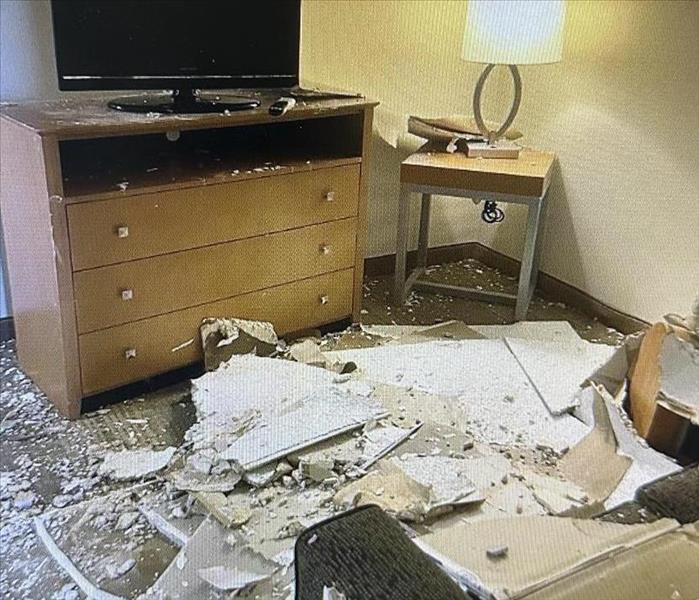 Ceiling collapses in a hotel room after frozen pipe bursts, damaging the contents below
Ceiling collapses in a hotel room after frozen pipe bursts, damaging the contents below
Below-freezing temperatures during the Midwest winters lead to rampant frozen pipes and pipe breaks in homes, schools, and commercial buildings. Frozen pipes are tricky: they can be difficult to prevent and detect, and can cause a lot of damage in a short amount of time.
A frozen pipe recently burst in the ceiling of an unoccupied hotel room, with the weight of the water causing the panels to collapse onto the room below. Fortunately, our SERVPRO team was there to help.
Our crew was able to extract any standing water from the room, remove any debris and unsalvageable contents, and properly dry out the area. Furniture was transported back to the warehouse so that it could be dried, cleaned, and restored to its original condition so the hotel room could be put back to use in no time.
We've Got the Right Tools for the Job.
11/7/2023 (Permalink)
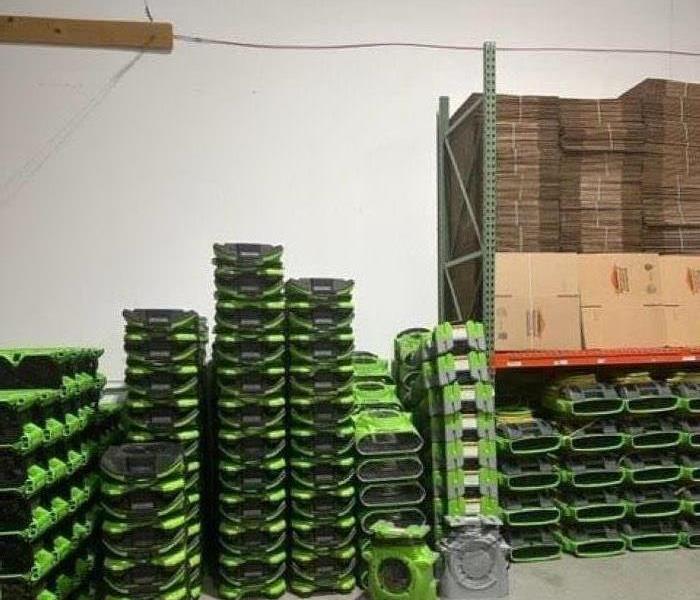 Is there a draft in here?
Is there a draft in here?
Water damage restoration comes in many shapes and sizes. Whether it's a leaking faucet, broken refrigerator line, or flooded basement, SERVPRO of Mt. Prospect North Des Plaines has the right tools for the job.
Air movers are used for drying structures. We have over 300 air movers ranging from the old school "snail fans" to today's low amperage, high output air movers. The air movers come in many sizes and can be used in a variety of drying needs.
Our SERVPRO Hero Ready trained technicians are schooled in making the correct choice of equipment for each individual job. Using the proper equipment can reduce the drying time and cost of a project. The choices can be critical to the success of the drying project.
Flooded Basement? That's Our Specialty!
10/7/2022 (Permalink)
It happens to everyone. Sump pumps fail, pipes burst, sewer lines back up. There is a myriad of reasons basements may flood, and we at SERVPRO have seen it all. Luckily, we are IICRC certified professionals, meaning we utilize industry-standard practices and procedures to make sure your flooded basement is properly taken care of.
After the initial assessment, a crew chief will discuss with you and (if going through insurance) your adjuster regarding the work to be performed, ensuring everything we do is pre-approved and signed off on. When done properly, your basement can be dried out within three days by following standard procedures and utilizing the most effective drying equipment available.
24/7 Response
At SERVPRO of Mount Prospect/North Des Plaines, we understand time is of the essence when it comes to saving your flooded basement. That is why we make ourselves available 24/7, with an on call crew ready to respond to your emergency situation and be Faster to Any Size Disaster. Call us today at 847-956-1880 to begin the restoration process!
We Can Handle Your Water Loss Damage
10/7/2022 (Permalink)
Having an accident or flood can be a devastating experience. Even a little water can lead to significant damage if given enough time. It can affect your belongings, furniture, and even the structural stability of your home.
When facing water removal issues in your Elk Grove area home, it is important to have a trained professional on your side. You want to locate the source of the problem, get excess water out of your home, and have someone available to deal with unsuspected damages.
SERVPRO has 24-hour emergency service, IICRC certified technicians, industrial-grade equipment, and years of experience providing extraction, drying, cleaning, and repair services for customers just like you. We understand how water works, making its way into cracks and crevices, leading to expensive damages.
Our technicians use infrared moisture detectors to locate even the smallest amounts of water, water extractors of all shapes and sizes, along with drying and dehumidification equipment to get water out of your home in a quick, efficient manner that limits any losses you may experience.
We can perform wet carpet removals, content, and structural decontamination, humid or flooded basement cleanup services, as well as complete structural drying. We even make sure that the inside of your walls remains entirely moisture-free and perform mold remediation services when necessary to help you maintain a clean, healthy home.
Attempting to perform your water removal services alone leaves you with hidden pockets of water throughout your home that can cause excessive damages in the future. Without the right tools and experience, everything can get out of hand quite fast, leaving you with a huge mess and significant problems that you simply do not understand.
We can provide you and your family with the services you deserve. By assigning qualified technicians, we help return everything to normal in a quick, efficient manner, after an emergency occurs.
Get the help you need by calling SERVPRO of Mount Prospect/North Des Plaines, today! (847) 956-1880.
Does Renter Insurance Cover Water Damage
9/1/2022 (Permalink)
If you are renting a house or apartment in Mount Prospect, IL, you have probably purchased renter's insurance to cover your belongings in the event of a disaster. You might be wondering, though, how far your coverage extends. Renters should be aware that most policies do not protect a tenant's belongings in the event of a flood.
What Is Covered by Insurance for Renters?
A regular policy for renters will cover your items if something happens to your belongings, including water damage from a burst pipe, certain plumbing issues or a broken appliance. However, a basic policy will not cover damage from flooding. Flooding can be caused by:
- Heavy rain
- Too much snow
- Rising water
- Sewage backup
Renters will need to purchase a separate flood insurance policy for these types of disasters.
Do I Need Flood Insurance?
If you do not live near the coast or in a flood plain, it's easy to dismiss the idea of purchasing flood insurance coverage. However, even a minor flood can be expensive. FEMA estimates that even one inch of water can do thousands of dollars in damage to the contents of a dwelling. Flood insurance will help pay if you need to replace your belongings or use a commercial restoration service. Flooding can happen in any of the 50 states. If you want guidance determining your risk level for flooding, consult FEMA's flood map service to see what zone you live in.
How Can I Purchase Flood Insurance?
The National Flood Insurance Program, or NFIP, is a division of FEMA that provides flood insurance in the United States. The insurance is sold through private companies. Because prices are set by the government, they are consistent no matter what company offers it. Prices will depend on what kind of dwelling you live in and your geographic location. Ask your insurance company if it sells flood insurance.
If you want complete protection for your belongings, make sure your renter's insurance policy is up to date and consider adding flood insurance coverage. You will have peace of mind knowing you're prepared if you need to make a claim.
Leaking Spigot at Your Home
8/1/2022 (Permalink)
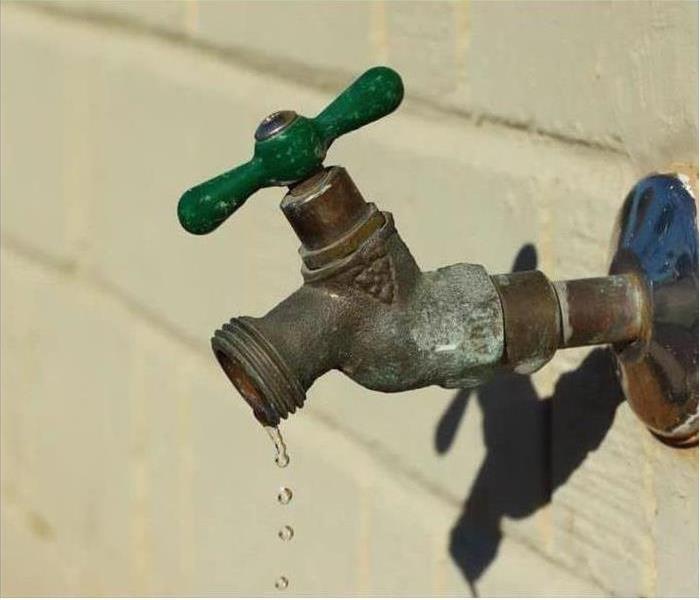 A leaking water spigot can cause significant damage to your home.
A leaking water spigot can cause significant damage to your home.
Summer is fast approaching, which means acts associated with using your outside hose become more common. Whether that be watering your grass, watering your plants, or filling up a pool. With this becomes the danger of discovering your outside water spigot froze over the winter and cracked, leading to possible water damage in your home the first time you turn it on. Often times, most people do not realize there is a problem until after it is far too late. Having someone in the house while you turn it on for the first time to watch and see if they notice anything can go a long way in limiting damage. If you discover there is a leak, you should use the shut off valve located in the house to turn off the water supply. Immediately contact a plumber to have them out to inspect the spigot. If water damage has taken place, be sure to call SERVPRO of Mount Prospect/North Des Plaines right away to ensure the project gets taken care of efficiently and correctly.
3 Reasons You Might Find Water in Your Crawl Space
6/2/2022 (Permalink)
Three Possible Causes Of Water In Your Crawl Space
A wet crawl space can create more problems than you might expect. It makes water damage less visible, but it also creates the perfect conditions for mold growth. The moisture also weakens the homes structural materials, creating greater damage as a result. Learn about the most common causes for water inside the crawl space so you can prevent an incident.
1. Overwatered Plants
You can accidentally flood the crawl space by doing something as simple as overwatering plants, especially those close to the house's foundation. Whether you use too much water or leave the hose or sprinkler running beyond the necessary time, the excess will seep into the house and reach the lower sections first. You can easily turn off the water to resolve this issue. You can spot this problem if you see water pooling near the affected area.
2. Poor Sloping Grade
Another factor that can result in a wet crawl space is the lack of proper grading around your house. Ideally, you want the grading to slope away from the building and towards the outer yard or the streets. This feature ensures that any incoming water flows away from the foundation, preventing flooding. Check the grade after winter, intense rainfall or an overwatering incident. If the slope is altered or missing, build it up between six to eight inches away from home.
3. Defective Plumbing
Another reason why you might find water inside your crawl space involves defective or broken pipes. Even if the leak or burst pipe is in the house's upper floors, the water will always trickle down. If you find water in the crawl space or lower area, conduct a detailed search to find the source and fix it. Hire a plumber if you are unable to find it.
You should deal with a wet crawl space fast before mold growth and water damage threatens your home. Identify these occurrences to avoid this situation and contact emergency remediation services if you find water in that area or anywhere else.
Drain Cleaners and Their Effect On Plumbing System
12/22/2021 (Permalink)
Most homeowners have experienced a clogged drain at some point. There are a number of cleaners on the market designed to take care of just such a problem, but what exactly do they do? Can using a cleaner damage your pipes, and are there safer alternatives out there? Here are a few things you may want to know about drain cleaners and their effect on your home’s plumbing system.
1. How Many Drain Cleaners Work
A drain cleaner typically works by producing a heat-causing chemical reaction, which can push through and break up a clog. The chemicals used are usually either caustic like lye, acidic such as muriatic acid, or oxidizing like bleach. All of these can lead to damaged pipes over time.
2. What Damage They Can Cause
When pouring chemicals to clear a clogged drain, it’s important to take caution as some can cause skin irritation or even burns depending on the strength. These chemicals can have the same effect on your pipes. If left to sit too long they can work through older metal or plastic pipes, and cause a leak which can lead to water damage in your home. If you have water damage from a leaking pipe, it’s best to contact a professional at SERVPRO of Mount Prospect/North Des Plaines.
3. Safer Drain Cleaning Alternatives
There are some safer alternatives for clearing a clog, whether it's a sink drain or sewage cleaning need. One of the first the many people think of is a drain snake in which a tool is inserted into the drain to pull the clog out. Other options include plungers and non-toxic cleaners. Non-toxic cleaners are comprised of enzymes that can eat through the clog. They may take a little more time, but should not harm your pipes.
Cleaning a clogged drain doesn’t have to leave you worried about damaging your home. Not only are there pipe safe alternatives out there, but if you’re unsure about the clog a professional can take care of the problem for you.
Reasons Your Toilet May Be Leaking
12/1/2021 (Permalink)
Our toilets are one of the most common causes of leaks in our homes. While it may not be leaking out onto the floor, it can still be leaking inside. This can cost you money.
If there is water around the base of your toilet, you need to address it right away. There could be a lot of damage happening beneath the surface, and it may have been going on for some time.
8 Reasons Your Toilet May Be Leaking
Water leaking around your toilet can soak into the floor and beyond.
1. Cracked Tank or Bowl
While tanks and the bowls are pretty durable, they can get cracks. These often start with a small, hairline crack, but can get bigger. Toilets may get shifted or jarred and can get cracked in the back where you won’t notice them. They may have simply been faulty, as well.
2. Worn Washers
There are two large bolts that keep the tank attached to the bowl, and two more that keep the toilet bolted to the floor. If the bolts or washers get stripped, rusted out, break, or wear out, they won’t be able to hold it all together.
3. Pipe Corrosion
There could be corrosion in your pipes because of age, impurities in the water, or heavy metals in your water. Rust will develop in the metallic portions of the toilet because of this corrosion.
Pipe corrosion can often cause a lot of damage because you often don’t know it is even there. It starts inside the pipes, so it could be there for a long time before you even see any signs of trouble.
4. Float
The float is the hollow ball that floats on the surface of the water in your toilet tank. It can become unhooked, cracked, or it isn’t lined up properly, the fill valve may run too much, causing a leak. The chain may come off, or if it gets a crack, it can take on water and not work properly.
5. Faulty Supply Line
If there is any kind of damage to supply lines, it can put a major strain on your toilet. Sometimes, if the joints in a supply line come undone and break down, water starts to drip out. The rubber lining in a supply line can also start to leak after several years.
6. Worn-Out Fill Valve
The fill valve on the toilet can also wear down over time. This is often due to mineral deposits, but they can also rust. If enough builds up to warp the fill valve, it can stop working properly, preventing your toilet from shutting off and causing leakage.
7. Stuck or Worn-out Flapper
The flapper is that plug in the bottom of your tank. It releases the water when you flush. If it gets stuck, either open or closed, you have a problem. This can also happen if your handle is stuck.
If the flapper is stuck open, the fill valve will not shut off, so it will just keep running. If the flapper wears out, no longer fits properly, or gets a tear, then it will not be able to regulate the water in the tank.
8. Broken Connections
Your toilet has many different connectors that prevent water leaks. If any of these connections lose their seal, water may end up on your bathroom floor. You can check your toilet’s connections to see if there are any problems before they turn into leaks.
Ice Dams - What are they and how do you prevent them?
10/25/2021 (Permalink)
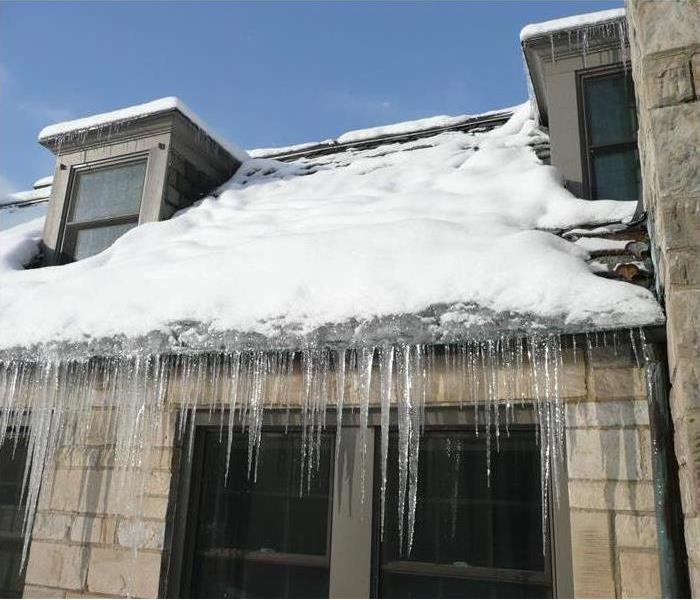 Icicles can be a pretty sight, but can also be a source of water damage!
Icicles can be a pretty sight, but can also be a source of water damage!
Winter water damage can take form in many different ways. One of the most neglected areas of water damage occurs right above you in the form of ice dams. These occur when warm air in the attic heats the roof, which melts the snow. The melted snow then freezes on the unheated eaves, which can look like icicles hanging above. While this can be a pretty image, it can cause damage if it is not dealt with.
Prevention Tips
- Have your gutters and downspouts regularly checked for any obstructions that may cause water backup.
- If enough heat is escaping into your attic to melt the snow above, you should check to ensure the attic is insulated properly. Check for any openings in the floor and seal them to ensure an airtight surface.
- In addition to insulation, ensure there is enough ventilation to allow warm air to escape.
- Use a roof rake or a long-handled brush to remove excess snow from your roof.
- Installing a water membrane or snow shield underneath the roof shingles can help to prevent water from seeping in.
- Gutter screens can help keep debris out that can cause build-up and damage.
Call SERVPRO of Mount Prospect/North Des Plaines for 24/7/365 emergency services related to water damage! 847-956-1880
The Science of Drying
10/1/2021 (Permalink)
Did you know there is actually a science behind the process of drying? The knowledge of psychometrics is essential to restoring a water damaged structure to its preloss condition. While your initial reaction maybe to grab a few towels to mop up the mess and place a fan or two around the damaged area, SERVPRO of Mount Prospect/North Des Plaines employees are trained in the science of drying and follow strict industry-approved standards to help lower the chance of any secondary damage. If your business suffers a water damage loss, SERVPRO of Mount Prospect/North Des Plaines will:
Inspect the building to detect every component that is wet, to help prevent secondary damage from happening.
Measure how much moisture is in what materials and monitor whether the materials are drying properly.
Speed up Mother Nature by using professional drying equipment.
Signs That You May Have Hidden Water Damage in Your Home
8/10/2021 (Permalink)
Identifying signs of water damage to your home sooner rather than later can make a difference in lessening the damage and the costs to repair and restore your home back to normal. SERVPRO technicians are ready 24/7 to respond quickly to floods, burst pipes, and other mishaps, saving time and money by getting to the job site faster. By identifying and treating problems earlier, we can help to prevent situations such as mold growth and severe oxidation from causing damage to the structural components of your home. Here are a few signs that may indicate water damage in your home.
Discolored materials
Many materials common in homes show water damage through discoloration. Pigments used in fabrics, paints, flooring, ceilings, and other surfaces can change color when they come in contact with water. The shape, spread, and specific color of these spots can vary depending on how much water has been released, and what materials it has already come in contact with. One of the most destructive processes in a water-damaged home is color bleed from one fabric to another, but a call to SERVPRO can help to avoid color bleeding by addressing issues as quickly as possible.
Unusual or musty odors
Several complications of water damage can create unusual and off-putting odors, sometimes very soon after the damaging water incident happens. Oxidizing metals, freshly soaked wood, and other materials, and long-term mold growth can all create unique and pungent odors in your home. While smells can be useful to identify a problem, you don’t want them around forever! That’s why SERVPRO technicians use multiple deodorization methods to rid your home of any unwanted smells. If you notice an unusual smell in your home, call the pros to get the problem handled quickly!
Dripping or other water sounds
Unusual sounds behind walls and below floors could be indicative of a water leak or other plumbing issue in your home. Drips may be obvious when you hear them but be alert for other unusual sounds as well. Water at high pressure inside pipes in your home can create unique sounds when something is amiss. It might be a whooshing sound or even a hum. If you hear anything unusual behind those walls, give us a call!
SERVPRO of Mount Prospect/North Des Plaines helps homeowners who experience water leaks, floods, and other disasters in their residences, helping get their homes back to normal. Call us at 847-956-1880 if you experience water damage of any kind.
How To Use IICRC Classifications To Assess Flood Damage
6/23/2021 (Permalink)
If you have endured flood damage to your Des Plaines home – SERVPRO of Mount Prospect/North Des Plaines can help you. We are an experienced flood damage restoration and repair team, with access to sophisticated tools and the finest equipment. If your property needs saving, we are the right choice. The first that thing we do, once we arrive on site, is to conduct a full inspection. This is designed to help us determine the extent and nature of the damage. The IICRC (Institute of Inspection Cleaning and Restoration Certification) categories flood damage according to four key classifications. The SERVPRO technicians will use this guide to shape their plan of action and decide which repairs are required.
Here is some more information on the IICRC classifications and what they might mean for your property.
Class One: Limited Intrusion
This is the least severe type of flood damage. A small amount of water has entered the home. There is minimal damage to walls and soft furnishings. Depending on the size, shape, and location of the affected space, large fans can likely be used to dry it out.
Class Two: Intrusion With Some Spread
Here, flood water has started to spread. If your house was impacted by a storm, the damage is almost going to have advanced beyond small pools of water. It may have risen into the walls and started to soak into timber, concrete, and insulation materials. The water has reached the subflooring beneath carpets. Industrial drying machines (and carpet lifters) will be brought in to absorb the excess moisture.
Class Three: Invasive Liquid
The walls, ceilings, soft furnishings, and floors are all damp and need to be dried quickly. Most are fully saturated with water. Water lines on the walls extend more than two feet above the floor. This tends to occur when ceilings leak (during heavy rainfall), and water seeps through the walls. Dehumidifiers and dryers can be used to restore the home, but some materials may be unsalvageable.
Class Four: Severe Invasion
In the most severe cases, objects not usually affected by flooding have been compromised. For instance, paintings high up on walls, attics (if the danger is from natural flooding), and crawlspaces. At SERVPRO, we’re committed to saving as many of your possessions as possible, but extensive damage can render some items irreparable. We will, however, inform you of the fact before disposing of any materials. Serious flood damage may require you to move out of the property while we secure its structural safety and install heavy duty drying machines.
Whether your home has been damaged by a storm or by something more familiar, like a burst pipe, assessing the damage is an important part of formulating a response. SERVPRO of Mount Prospect/North Des Plaines is a locally based service, which means that our response is always fast.
What To Do If Water Damage Occurs
5/26/2021 (Permalink)
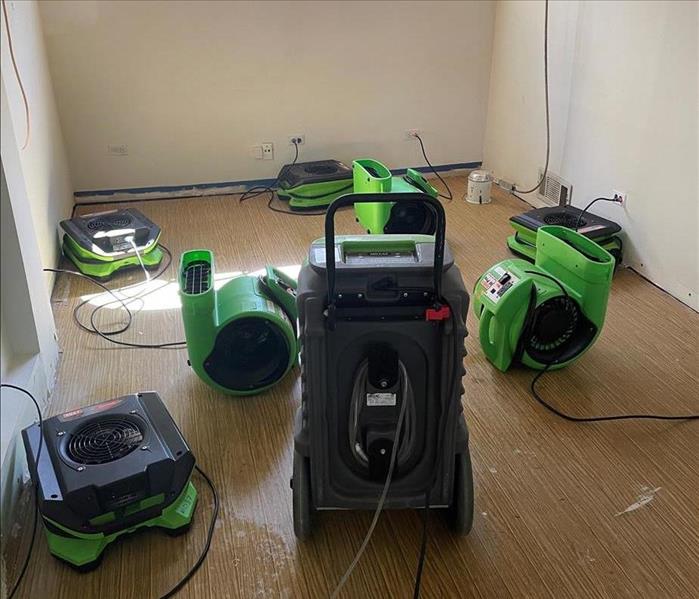 Drying Process in Place
Drying Process in Place
Step 1 – Stop the Water, if possible
Step 2 -- Call SERVPRO of Mount Prospect/North Des Plaines at 847-956-1880
We will ask for:
- Your name.
- Address (please let us know if your mailing address is different than the property address).
- Telephone numbers.
- How did you hear about us?
- What type of damage occurred (water, fire, etc) and what caused the loss?
- How many rooms are affected and the type of flooring in the affected rooms?
- Is your home on a concrete slab, crawlspace, or basement?
- Year your home was built.
- We will ask what company your homeowners’ insurance is with. If you have a claim number and / or adjuster information already (if not, no worries).
- What your deductible amount is?
- The deductible is the amount you pay before insurance starts to pay. We generally collect this amount at the start of service, but this can vary depending on the insurance company.
Step 3 – Call A Plumber, if needed
Step 4 – Call Your Insurance Company
In order to get things under way quickly, contact the Claims number for your insurance company. They will ask for some information about the loss and what damages there are. If you’re unsure what your deductible amount is, they will be able to tell you. If they assign a claim number and / or adjuster, please take that information down and give it to us. Tell them you have SERVPRO of Mount Prospect/North Des Plaines on the way. Some people like to speak to their agent, which is fine, but the agent isn’t typically available at all times and many times there’s a delay before the agent has some time to file the claim.
We will extract the water and move any necessary contents when we get there. Just keep yourself safe, it's very easy to be injured during a water damage situation.
Can Drain Cleaner Damage Pipes?
12/28/2020 (Permalink)
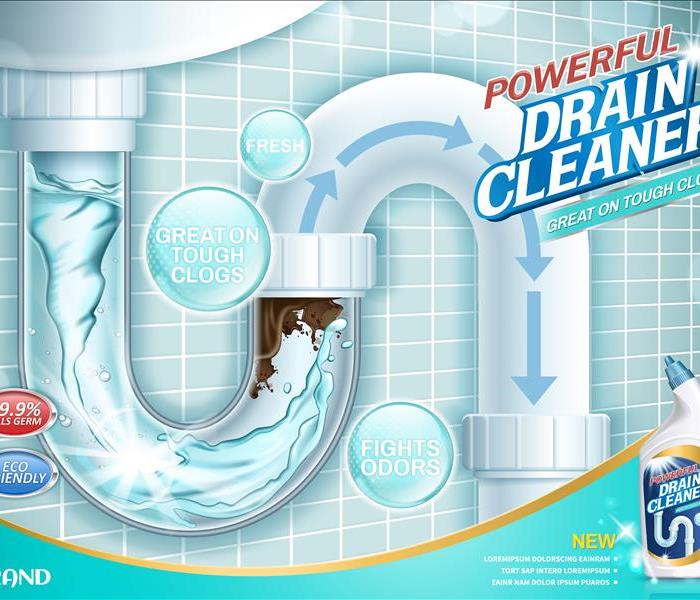 Chemical drain cleaners can cause more problems than they fix
Chemical drain cleaners can cause more problems than they fix
Can Drain Cleaner Damage Pipes?
If anyone in your North Des Plaines, IL, household has long hair, you are probably all too familiar with having a clogged drain. When you are trying to use the bathroom sink to brush your teeth, nothing is more frustrating than watching water collect in the basin. Out of annoyance, it can be tempting to grab a bottle of drain cleaner from your local store, but should you? Sometimes, chemical drain cleaners can cause more problems than they fix.
When You Should Not Use Drain Cleaners
Drain cleaners can solve minor issues when it comes to a clogged drain, but you should not use them regularly. Over time, the chemicals inside the cleaner can wear away at piping. That said, there are some instances when you should not use drain cleaner at all on your drains. Examples of these times include:
- When you have plastic pipes
- When you have old and/or weak pipes
- When the drain is completely clogged
If any of these situations apply to you, it is better to contact a sewage cleaning professional to assist with your problem.
Problems With Drain Cleaners
Why can drain cleaners be so harmful? It comes down to how they work. When there is a big clog in your pipe, drain cleaners work through it by using heat. This heat is usually generated through one of three chemicals: caustic, oxidizing or acid. These create powerful chemical interactions that work by corroding away buildup. In the same way, they can also cause corrosion to the pipe. Another problem that arises is having a clog caused by fats, oils or grease. Referred to as "FOG clogs," these kinds of drain clogs can lead to further blockage because the clog is simply pushed further down the pipe into a harder-to-reach location.
While drain cleaners can sometimes be useful, it is important to think about their risks. It is always wise keep your home's unique piping conditions in mind before pouring any chemicals down a clogged drain.
How To File a Water Damage Claim
11/24/2020 (Permalink)
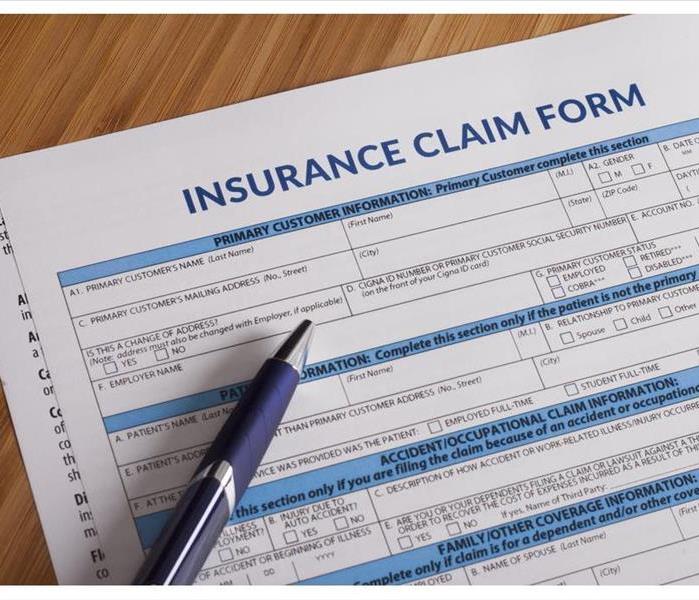 Homeowners may file an insurance claim, seeking financial assistance in the restoration efforts
Homeowners may file an insurance claim, seeking financial assistance in the restoration efforts
Follow These Four Steps
When a home in Mount Prospect, IL, suffers from water damage, homeowners may file an insurance claim, seeking financial assistance in the restoration efforts. The process, for many, may seem intimidating, but it doesn't have to be that way. By taking initiative and remaining organized, residents can make the experience easier. It's important to follow these four steps, always remembering to record every effort made.
1. Report the Damage
If the flood destroyed structural materials and personal belongings, immediately call your insurer to request assistance. It's important to relay the details of the initial event and ask questions about your policy. Double-check the deductible amount and the total coverage that is available.
2. Arrange for Inspections
Obtain an assessment from a water remediation company. The professionals should check the moisture saturation levels and determine how much tear out, drying and construction are needed to repair the space. In addition, the insurer should send an adjuster to review the premises. Be available during this time to walk the property together and point out any problems. The company uses the adjuster's report and other estimates to evaluate the insurance claim.
3. Photograph Everything
Evidence of the issues is important. Before any work is done, take photos of the pipe burst and any subsequent destruction. Soggy carpets, ruined drywall and soaked valuables should be noted. Usually, policyholders have both personal loss and property loss coverage. Be sure, therefore, to record everything of concern. Save these in a file on your computer and share them with the agency.
4. Submit Receipts
Begin any immediate cleaning. Delaying too long could cause further complications. Make a list of all the expenses. Send this itemization with the receipts to your insurer to file toward your insurance claim.
Don't hesitate to work with your insurance agency to get the monetary support required to fix your house after a pipe burst or flood. Remember to remain clear and structured with each step.
4 Ways to Clean Pipes and Avoid Chemicals
10/13/2020 (Permalink)
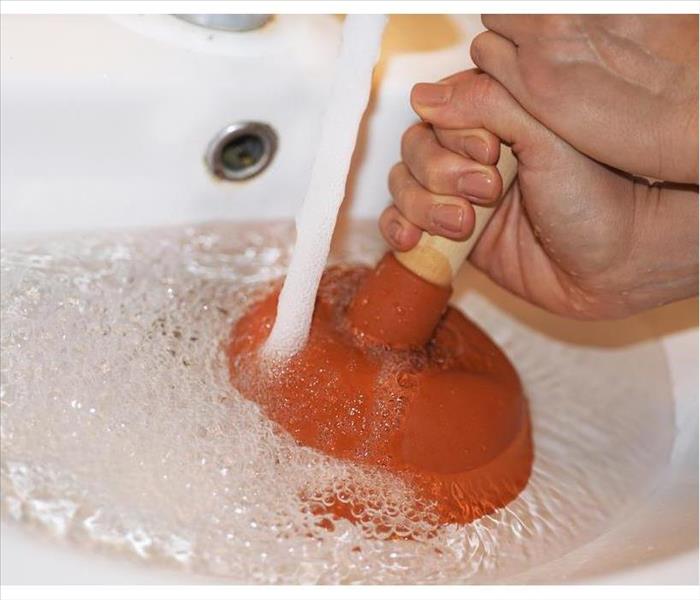 A plunger can be used to unplug any drain where it can gain suction
A plunger can be used to unplug any drain where it can gain suction
Four Alternatives To Chemical Cleaners
When your sink gurgles, your instant reaction is to reach for the drain cleaner, but it should be your last resort when clearing a clogged drain. First, try these four alternatives to chemical cleaners:
Grab a plunger. It is not just meant for toilets. A plunger can be used to unplug any drain where it can gain suction. Often, it only takes a few minutes of plunging to clear minor clogs.
Use a wire hanger. Bend a wire coat hanger so that you create a long handle by straightening out the corners. Use your newly created hook to “fish” down into the clogged drain and pull the blockage out. This works especially well for shower drains where hair tends to build up.
Mix up some baking soda and vinegar. This classic combination of non-corrosives is used for all sorts of household remedies, so it is not a surprise that it can be used to clear drains. In this case, you use boiling water as a heating agent to create a reaction.
Call a plumber. Even if you get a stubborn clog to move, it doesn’t always completely leave your system, or it clogs up other sewage pipes. Having a sewage cleaning expert take care of the problem right away will save time and money.
By trying some of these methods, you can prolong the life of your pipes.
Why You Should Avoid Chemicals
Drain cleaner is made up of different chemicals that work by creating a reaction to dissolve clogs. The reaction creates heat to break down the blockage. As a result, it can weaken pipes, causing them to break and costing you more when you have to call in a local water damage company to clean up.
Fixing a clogged drain with a chemical cleaner might be easy, but there are other alternatives that are better for keeping both your pipes and the sewage system in North Des Plaines, IL, flowing.
What Is Category 2 Water Damage?
8/20/2020 (Permalink)
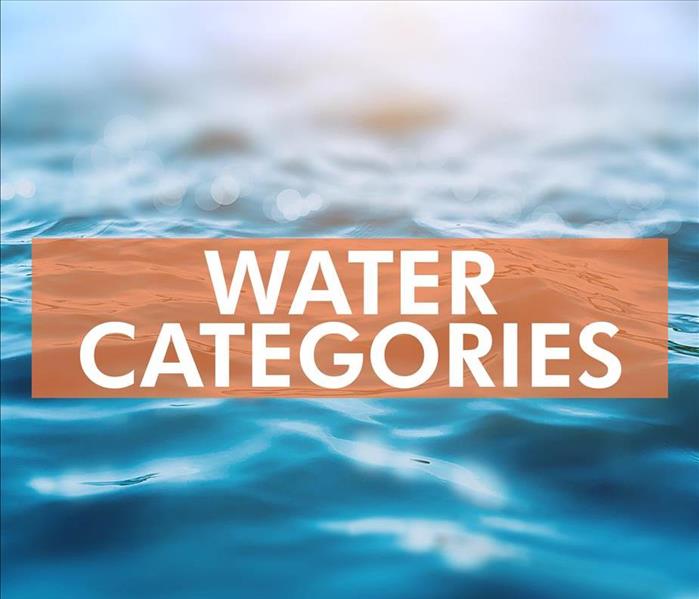 There are three primary types of water categories
There are three primary types of water categories
Flooding is a scary occurrence for homeowners. If left unchecked, floods can result in subsequent issues, such as water damage and mold growth. There are several different types of floodwater as well, each requiring their own specific remediation methods. If a lack of water pipe repair has caused issues for your home in North Des Plaines, IL, you might want to learn how to resolve Category 2 water damage.
Types of Flood Water
There are three primary types of floodwater, each categorized by the types of contaminants present in the flood.
Category 1: Category 1 water damage is characterized by a complete lack of contaminants. Clean water floods are, in theory, safe for human and animal consumption, but you should still never attempt to drink flood water. Category 1 floods can become more dangerous if they come into contact with other contaminants.
Category 2: Category 2 flooding is typically a result of a broken pipe or overflowing household appliances. Dirty dishwater or runoff from a laundry machine is usually to blame for this type of flood.
Category 3: Category 3 water, also known as blackwater, is the most dangerous type of flooding. It often contains human fecal matter, raw sewage or other types of dangerous biohazards. You should never attempt to remediate this type of flood without professional help.
Preventing Category 2 Flooding
The best offense in the war against water damage is a good defense. Prevent Category 2 flooding by regularly inspecting household appliances and exposed water pipes. Water pipe repair is also vital; if you come across a broken pipe then you need to patch the leak immediately.
Regular water pipe repair is an excellent way to protect your home against Category 2 flooding. Unfortunately, not all water pipes in your home are easy to inspect. Hidden pipes can burst and result in flooded walls and ceilings as well. If this is the case, you need to contact flood remediation experts to help you resolve the issue.
What Can Cause a Flooded Basement?
6/2/2020 (Permalink)
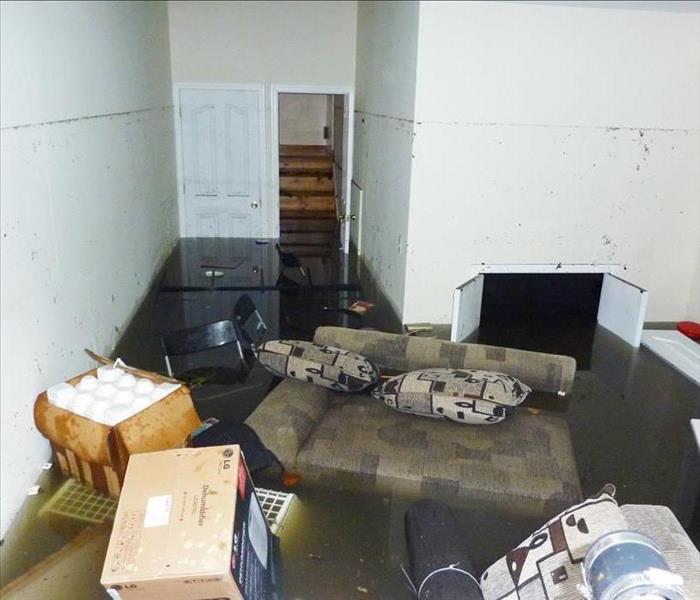 A basement flood can be devastating for a homeowner
A basement flood can be devastating for a homeowner
Four Common Reasons For Flooded Basement
A basement flood can be devastating for a homeowner. Unwanted water can range in severity from a small trickle to floodwater that covers electrical outlets. By knowing some common reasons that basements flood, you may be able to take preventative measures and lessen the chance it will happen to you. Here are four common reasons for flooded basements and what you can do about them:
1. Blocked Gutters and Eavestroughs
If leaves or other debris get into your gutter system, it can change the water flow around your house or block the manifold that connects your home to the public sewer system. Have these areas checked and cleaned regularly, especially in the fall after the leaves have fallen.
2. Location of Your Home
If your home sits at the bottom of a slope, you may have a problem with water flow. As the water gathers around your home, it can seep in and cause water damage. Often, time will take care of this problem with erosion. To speed up the process, you could install some landscaping to guide the water away from your foundation.
3. Poor Construction
If flooring and wall tiles were not sealed properly, you may experience a basement flood every time there is a heavy storm. You can check these seals and have them fixed if you find a leak.
4. Drainage System
The downspouts around your home should direct the water away from the foundation. If your downspouts are within 6 feet of your basement wall or do not direct it in the opposite direction, it can cause a flooded basement. You may need to add additional piping or create a path for the water.
If you have experienced a basement flood in North Des Plaines, IL, it is safest to stay out of the water and call a professional for help. By enlisting the help of an expert water remediation company, you can have your home back to normal as quickly as possible.
Can a Water Leak Cost You a Fortune?
5/18/2020 (Permalink)
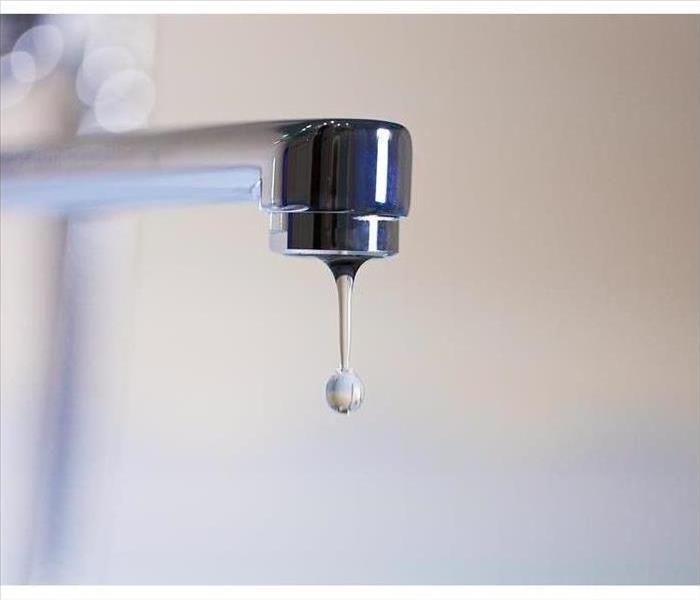 A dripping faucet can cause major water damage in your home
A dripping faucet can cause major water damage in your home
How a Minor Leak Can Become Major Trouble
A leak seems so minuscule. After all, it's only a tiny bit of water leaving a pipe or faucet. How could it possibly create so much harm? Those little drips, though, wear away at fixtures, materials, and dirt, slowly ruining your premises. In fact, much of it is invisible, hiding inside walls or under the ground, making the water leak an unknown significant danger to business owners in Mount Prospect, IL. Sometimes quite costly, what seems so innocuous is really very deleterious. Here are three things to understand about how a minor leak can become major trouble for your home or business.
1. How Does a Leak Occur?
Over time, pipes can create significant levels of water damage. Developing from rust, age or interference, holes in the piping can happen. Moisture then begins escaping, furthering the problem. You'll need to consider various factors. Outside, groundwork can interfere with your system. Also, trees can grow into pipes, puncturing them. Pay attention to your surroundings, noting any alterations in the ground. Unusual puddles, holes, or changes in elevation levels are signs of escaping fluid. Inside, if systems go unexpected, complications can arise within the walls. Work with a specialist to regularly evaluate the pipes.
2. Are You Responsible?
If you're not paying attention, a water leak can exacerbate quickly. Bills for utilities may seem a bit high at first, maybe only going up just a bit. You probably chalked it up to increased usage. Eventually, as the opening enlarges, it can add up into the thousands. As you work with a water restoration company to locate the issue, you'll need to understand where the event has occurred. Most often leaks inside the building are the responsibility of the owner. If the leak is outside, not on your property, it could fall onto the shoulders of the utility company.
3. How Do You Fix the Problem?
First, fix the pipe break. Then, work with the remediation team to dry up the area and sanitize the space. You'll need to evaluate anything wet, determining whether it's salvageable.
Be aware of the potential for a water leak. Note billing changes and have regular inspections.
6 Ways to Prevent Frozen Pipes This Winter
2/25/2020 (Permalink)
 It is also crucial to seal all cracks and gaps along your foundation
It is also crucial to seal all cracks and gaps along your foundation
Use The Following To Prevent That Big Freeze
With the winter months well underway, it is necessary to talk about home maintenance and pipe freeze prevention. One of the biggest threats to a house during the cold season is a frozen or burst pipe. Therefore, use the following six tools and tips to prevent that big freeze.
- Insulation
- Heat
- Heat Tape
- Sealant
- Drips
- Cabinet doors
Insulation
The first method to avoid frozen pipes is to use additional insulation around the supply lines. You want to pay particular attention to plumbing that runs along the exterior of the building, or that is exposed in basements and crawlspaces because these are most at risk to temperature fluctuations.
Heat
Next, for the supply lines inside the home, consider using space heaters aimed directly at the pipes. For example, if you know there are water lines inside of an external wall, try pointing a heater at that wall.
Heat Tape
The next line of defense in pipe freeze prevention is heat tape. There are several varieties of this type of tape, but it all works the same way, by using an electric current to keep the pipe from freezing.
Sealant
It is also crucial to seal all cracks and gaps along your foundation or supply line entry points. While some crack may seem insignificant, they may just be wide enough to cause temperature shifts and create problems for your plumbing.
Drips
When pipes freeze, they build pressure, which eventually leads to a burst pipe. An excellent way to prevent that buildup of pressure is to allow your faucets to drip. You don't have to let your faucets drip all winter, but when Mount Prospect, IL, is going to experience especially frigid temperatures, then it is a good idea.
Cabinet Doors
Last, on unusually cold nights, open the cabinet doors under sinks to allow the heat to circulate in. You can also place a heater aimed under the sink to keep the space warm.
All of the above pipe freeze prevention tips are helpful, but a water mitigation expert might be able to offer more specific advice. In any case, do what you can to stay warm and prevent disaster.
Maintaining Your Business's Fire Sprinkler System
1/30/2020 (Permalink)
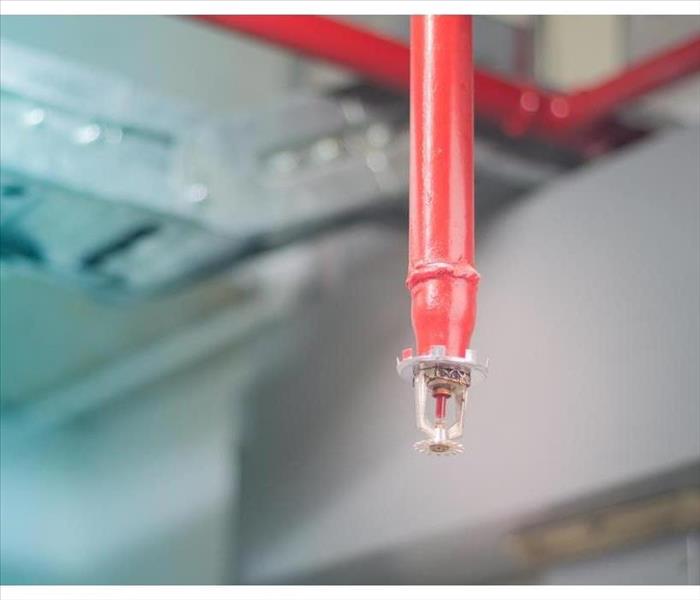 Sprinkler maintenance is important for preventing unnecessary damage
Sprinkler maintenance is important for preventing unnecessary damage
Safeguarding your business in North Des Plaines,IL, by installing fire sprinklers has the potential to stop a fire in its track, saving lives and preventing extensive damage to your building and business. According to the National Fire Protection Association, sprinkler systems reduce the chance of fire deaths occurring by 50 to 75 percent, and there is a 50 to 66 percent cut in the average property loss. However, neglecting regular sprinkler maintenance can lead to accidental activation, which can cause unnecessary water damage. It is essential that you know how to properly maintain your sprinkler system and know what to do if it goes off when no fire is present.
Fire Sprinkler Maintenance Tips
Your business’s sprinkler system should be inspected and tested by a professional at least every five years. During this inspection, the fire service professional should perform the following sprinkler maintenance tasks:
- Test control valves
- Remove dirt and grime from sprinkler heads
- Check water pressure
- Ensure no tall objects are blocking the sprinklers
- Look for signs of corrosion or rusting
- Ensure proper calibration
- Check pipes and plumbing connections
What To Do If the Sprinkler System Goes Off
There are several reasons a fire sprinkler goes off when it shouldn’t including neglecting maintenance, vandalism, and human error. If a contractor is working close to a sprinkler, accidental damage can cause it to spray. If this situation ever does occur, you can attempt to turn off the system if possible. It is a good idea to know where the shut-off valve to sprinklers are beforehand so you can turn it off if necessary. As soon a the sprinklers are shut off or turn off on their own, get in contact with a water restoration company that can address any damage that occurred.
Sprinkler maintenance is important for preventing unnecessary damage and ensuring the system works if a fire ever does occur. Always be cautious when working near sprinklers and call a professional if you suspect any damage has occurred.
Take Steps Now to Prevent Your Pipes From Freezing This Winter
12/9/2019 (Permalink)
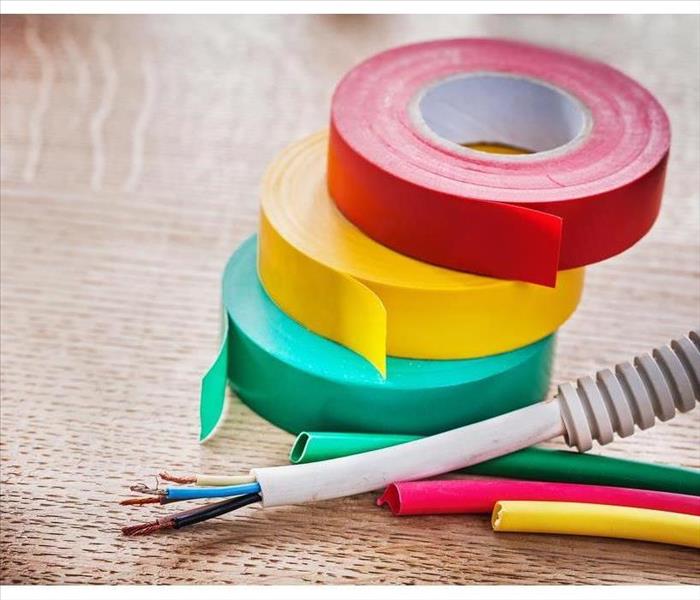 Use heat tape on pipes that are located in unheated crawlspaces or in the ceiling
Use heat tape on pipes that are located in unheated crawlspaces or in the ceiling
Your home in North Des Plaines,IL is a cozy and safe haven from the world where you and your family can enjoy warmth and security in spite of the frosty winter. What happens, however when that icy outdoors invites itself inside and causes frozen pipes, possibly even causing a burst pipe? Putting some pipe freeze prevention measures in place can save you the grief of a flooded home.
5 Pipe Freeze Prevention Tips
Icy walls and cold temperatures can cause pipes to burst and flood your home. Luckily, there are some things you can do to prevent most of them from happening. Here are a few ideas that may help
Wrap your pipes and fittings with pool float tubes split lengthwise to insulate them
Use heat tape on pipes that are located in unheated crawlspaces or in the ceiling
Open cabinets that house plumbing to allow room heat in
During frigid temperatures, turn your faucets to a fast drip or slow stream to keep pipes open
Make sure to disconnect hoses from any outdoor faucets and insulate them on the inside
Thawing Frozen Pipes
If you do get frozen pipes, you should never use a blow torch or fast thawing method as it could suddenly erupt and send water flooding through the basement. You should shut off your water supply, turn the faucets on. Place a gently heat source such as a space heater or infrared lamp close to the wall where the blockage is located. You can also turn the heat up in the house to slowly thaw the pipes.
Waiting too long to employ pipe freeze prevention tactics could result in a burst pipe, leaving you with damaged floors and carpets. When the water is from a clean source such as a water supply, then carpets may be saved. If the cleanup is more than you can handle, you’ll need to call a professional water remediation service in North Des Plaines,IL to help with cleaning and restoration. Your best bet is to take a proactive stance and protect your home before cold weather hits.
Mount Prospect/North Des plaines Residents: We Specialize in Flooded Basement Cleanup and Restoration!
11/21/2019 (Permalink)
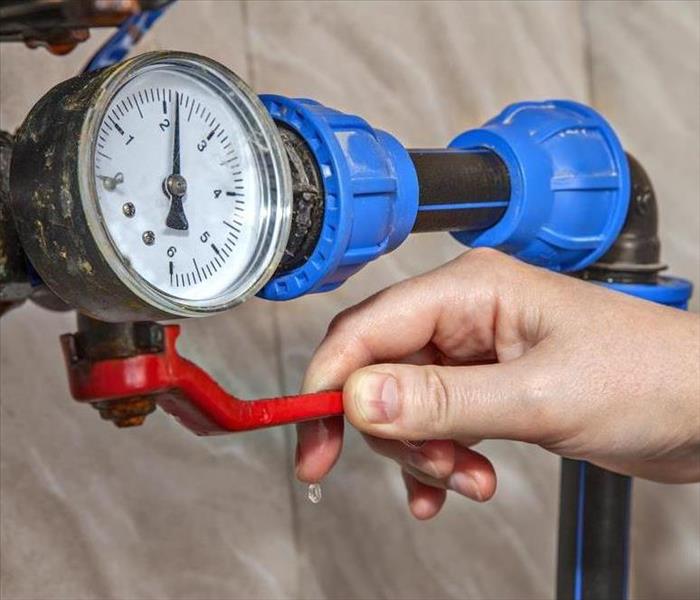 Basements are inherently prone to flooding.
Basements are inherently prone to flooding.
A basement can flood at any time, although flooding most often occurs during heavy rainfall. Basements are inherently prone to flooding because they are the lowest level of a building and are normally built partly or entirely below ground level. There are a number of reasons why your Mount Prospect/North Des Plaines basement could flood, including:
- A blocked or failed sewer lateral pipe
- Heavy rain causes surface water to pool around your home
- Storm sewer backup
- Sanitary sewer backup
- Foundation drainage failure
- Water supply-line break or hot-water tank failure
- And many more
Have Questions about Basement Flooding?
Call Today - 847-956-1880
If flood water is not handled quickly and properly, it can jeopardize your health and safety, and cause severe damage to your home’s structure. Remember, the longer you wait, the worse the problem will get.
The bottom line: a flooded basement can jeopardize your health, safety, and your home’s integrity. It’s worth making a call to SERVPRO of Mount Prospect/North Des Plaines and let our trained, professional crews handle the situation safely and correctly. We have earned the trust of hundreds of homeowners, business owners, and property professionals.
We are Flooded Basement Specialists:
- We are Available 24 hours/7 days per week
- We’re a Preferred Vendor to many National Insurance Companies
- We Bill The Insurance Directly – One Less Thing For You To Worry About
- Our Technicians are Highly-Trained in Water Restoration Techniques
- We use s500 IICRC Restoration Standards
- Advanced Inspection and Extraction Equipment
Basement Flooded? Call Us Today – We’re Ready To Help 847-956-1880
Faster to your Water Damage Event
11/20/2019 (Permalink)
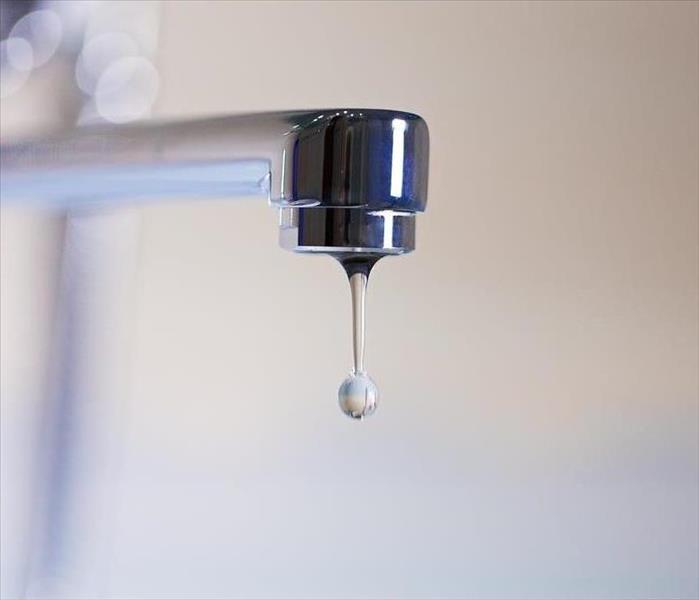 Water damage is our specialty
Water damage is our specialty
Flooding and water emergencies don’t wait for regular business hours and neither do we. SERVPRO of Mount Prospect/North Des Plaines provides emergency cleaning and restoration services 24 hours a day, 7 days a week—including all holidays.
Faster To Any Size Disaster
Flooding and water damage is very invasive. Water quickly spreads throughout your home and gets absorbed into floors, walls, furniture, and more. SERVPRO of Mount Prospect/North Des Plaines arrives quickly and starts the water extraction process almost immediately. This immediate response helps to minimize the damage and the cleaning and restoration costs.
Need Emergency Service? Call Us 24/7 – 847-956-1880
Water Damage Timeline
Within Minutes
- Water quickly spreads throughout your property, saturating everything in its path.
- Water is absorbed into walls, floors, upholstery, and belongings.
- Furniture finishes may bleed, causing permanent staining on carpets.
- Photographs, books, and other paper goods start to swell and warp.
Hours 1 - 24:
- Drywall begins to swell and break down.
- Metal surfaces begin to tarnish.
- Furniture begins to swell and crack.
- Dyes and inks from cloth and paper goods spread and stain.
- A musty odor appears.
48 Hours to 1 Week:
- Mold and mildew may grow and spread.
- Doors, windows, and studs swell and warp.
- Metal begins to rust and corrode.
- Furniture warps and shows signs of mold.
- Paint begins to blister.
- Wood flooring swells and warps.
- Serious biohazard contamination is possible.
More Than 1 Week:
- Restoration time and cost increase dramatically; replacing contaminated materials and structural rebuilding may be extensive.
- Structural safety, mold growth, and biohazard contaminants pose serious risks to occupants.
About SERVPRO of Mount Prospect/North Des Plaines
SERVPRO of Mount Prospect/North Des Plaines specializes in the cleanup and restoration of residential and commercial property after a fire, smoke or water damage event. Our staff is highly trained in property damage restoration. From initial and ongoing training at SERVPRO’s corporate training facility to regular IICRC-industry certification, rest assured our staff is equipped with the knowledge to restore your property.
Protect Your Home From Water Damage While on Vacation
11/7/2019 (Permalink)
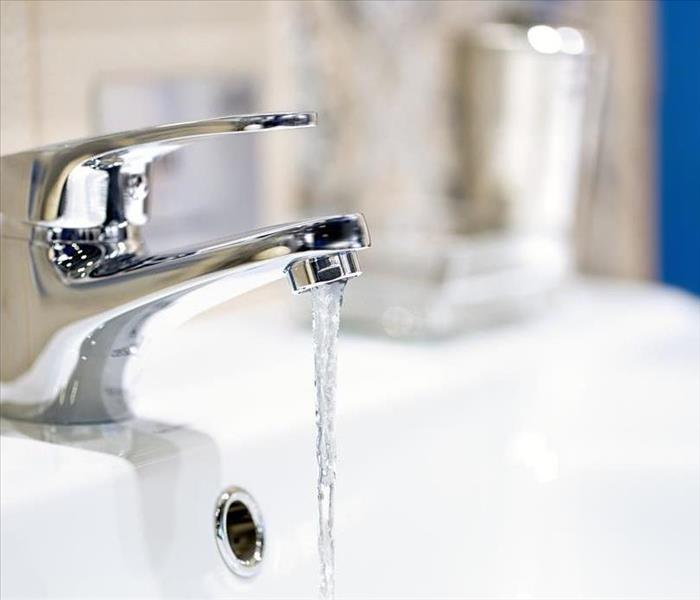 Make sure all of your faucets are off when you leave for a long period of time!
Make sure all of your faucets are off when you leave for a long period of time!
Nobody wants to return from vacation to find a flooded house in need of new carpet and water pipe repair. When a pipe bursts while you’re away for an extended period of time, water damage becomes more likely, which is why it’s important to take precautions. Before your next trip, follow these leak-proofing steps to help ensure a dry house when you return to Mount Prospect, IL.
Perform a Visual Inspection
Before you leave, carefully inspect your home for water seepage. Some common sources of household leaks include the following:
• Windows
• Pipes
• Large appliances
Around windows, look for discoloration of surrounding surfaces and ensure the seals are in working order. In addition to searching for a broken pipe, inspect for rust and cracks, as these are signs of weakness in the metal. Inspect the hoses that connect major appliances, such as dishwashers and water heaters, to running water, ensuring there are no tears or kinks. Perform this inspection in advance to allow yourself time to make a water pipe repair or get help from a professional if necessary.
Guard Against the Elements
During cold months, leave your thermostat set on low to prevent water from freezing and bursting your pipes. Insulate those outdoors with foam or fiberglass sleeves that are sold in hardware stores. If you’ll be gone for a considerable amount of time, consider shutting off the water at the main and draining pipes if temperatures may reach freezing. Look into digital detection systems, which notify you of leaks and can even remotely shut off water.
Enlist Backup
If possible, arrange for someone to occasionally check on your house while you’re away. Show this person your house’s water shut-off valve and instruct him or her how to use the thermostat. Since water damage requires a hasty response, be sure the individual knows to immediately call a plumber or water damage repair expert at the first sign of trouble.
When in doubt, be proactive. After all, who wants to ruin a vacation by worrying about water pipe repair? By taking simple precautions against leakage, you can avoid concern about returning from vacation to a flooded home.
What Is Category 3 Water Damage and How To Recover From It
11/6/2019 (Permalink)
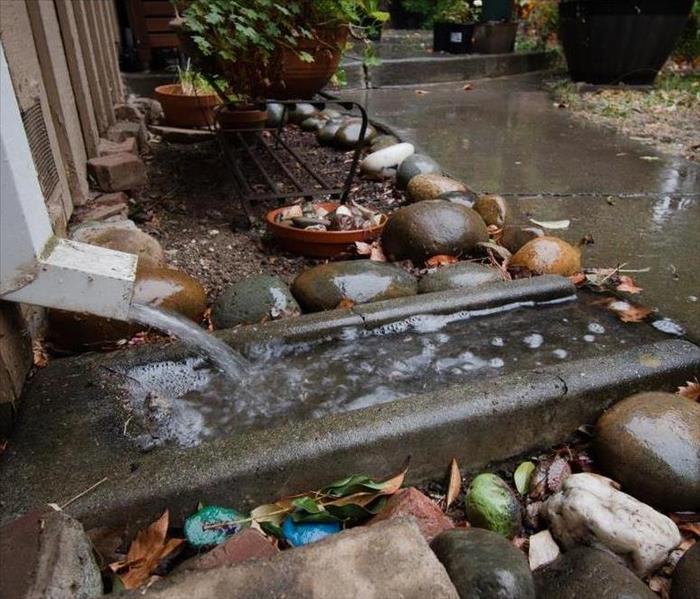 Water damage can cause serious damage to your home or business.
Water damage can cause serious damage to your home or business.
There is so much to consider when you experience flood water at your business in Mount Prospect, IL. One of the many considerations is what category the water is and what kind of recovery the resulting level of damage requires. The worst possibility is category 3 water. It is important to understand what you are dealing with and how to protect yourself and employees.
What Is Category 3 Water Damage?
Category 3 water damage is the unhealthiest level. It occurs when highly contaminated water, or flood water, infiltrates materials such as wood and sheetrock, leading to poor environmental conditions. This type of liquid can come from broken sewer lines, severe weather conditions, flash floods, backed-up sewer mains, and even toilet overflow.
Why Is Category 3 Water Damage Dangerous?
There are serious health concerns involved with category 3 water damage. The highly contaminated black water can carry pathogens that can lead to communicable diseases such as hepatitis, tetanus, HIV, tuberculosis, and West Nile virus. The water can spread quickly through a building, making it very difficult to properly clean up all the materials in which it can permeate.
How Does a Business Recover from Category 3 Water Damage?
To recover from a flooding event, it is important to allow a professional company specializing in water damage repair to thoroughly clean your building. Make sure the company is certified in category 3 damage. These professionals can ensure you meet OSHA and EPA standards at your place of business for the sake of all employees. If possible, move your workplace to another location during the cleanup process. Using a professional cleaning company can help reduce the spread of pathogens, aid in reconstruction of damaged structures, and help with recovering salvageable materials and personal belongings.
Cleaning up from a flood water event in your business is not easy. Do not risk your health and the health of your employees by trying to restore category 3 water damage by yourself. Call a professional instead.
How Water Affects Common Building Materials
11/5/2019 (Permalink)
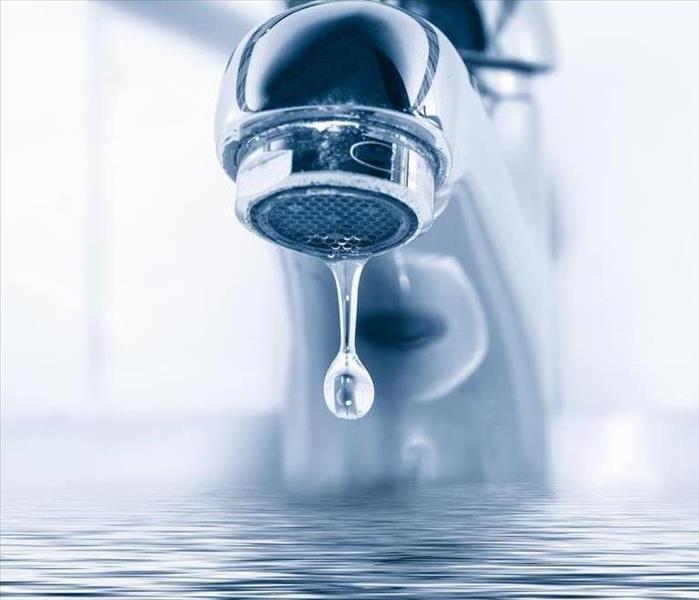 Water leaks can cause serious damage in your home or business.
Water leaks can cause serious damage in your home or business.
Large volumes of water can destroy your home’s internal structures. To minimize swelling wood and other forms of destruction, you need to quickly and efficiently remove standing water and eliminate moisture. Understanding how water destroys various building materials can also help you assess the salvageability of water-damaged items inside your home.
Dry-Soaked Objects
Eliminating water and moisture is one of the first steps of the cleanup process and is essential for damage control. You can utilize a variety of methods to expediate drying:
• Open windows
• Use fans and a dehumidifier
• Employ a shop vac to soak up pooled water
Wooden Materials
A common indication of water damage is swelling wood. Wooden structures inside your home that may be influenced by excessive water exposure include:
• Subfloors
• Baseboards and door frames
• Cabinets
When exposed to water, plywood may warp and delaminate. Particleboard can also bloat and distort. As a result, you may need to replace saturated subfloors. However, your ability to salvage wooden items will largely depend on the extent of water exposure.
Drywall Saturation
Both drywall and insulation absorb water. When saturated, drywall becomes soft and weak while insulation loses its R-value, thus reducing its effectiveness. Wet drywall and insulation can also become breeding grounds for mold and mildew. For this reason, saturated drywall and insulation should be promptly removed and replaced once the damaged area is dry.
Carpet Replacement
Like drywall and insulation, carpets and padding absorb water. Because wet carpets can also harbor mold and mildew, drying them quickly is essential. If the floor is extremely saturated, you may need to replace both items.
Professional Assistance
Every home in Mount Prospect, IL, is potentially susceptible to water damage. Removing standing water and quickly drying the area is crucial to minimizing destruction, including swelling wood. If your property suffers significant damage, you may want to hire a professional cleanup and restoration team. A licensed plumber can also inspect the water supply line, complete a water pipe repair to the damage and offer suggestions to minimize bursting pipes.
3 Parts To Check When a Commercial Toilet Keeps Running
10/30/2019 (Permalink)
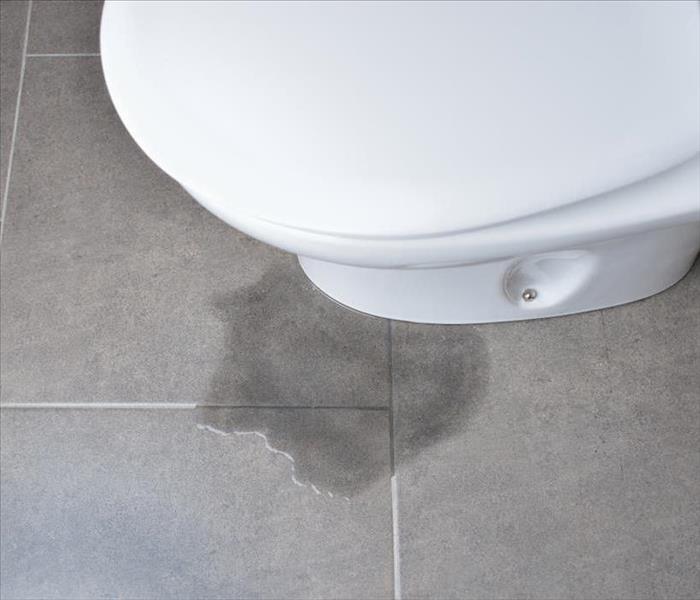 Toilet leaks and overflow can cause water damage on any property
Toilet leaks and overflow can cause water damage on any property
Your Mount Prospect, IL, commercial building’s toilets need to run efficiently for the comfort of your employees and customers. However, when a plumbing issue like a toilet overflow happens, it can be unpleasant for everyone. This problem may be caused by a variety of issues, but some can be fixed without the assistance of a plumber. If a toilet keeps running, there are several parts you can check before you call in a flood damage and cleanup service to ensure your bathrooms are properly dried and deodorized after an overflow.
1. The Gasket
Once you turn off the water, the first step to take is to open the winter flushometer. This is the part that causes a commercial toilet to flush efficiently. Use a screwdriver and a wrench to remove this unit’s lid. The gasket is usually located directly under the lid. If it contains a lot of debris or buildup, carefully remove and clean the gasket thoroughly.
2. The Weep Hole
A commercial toilet’s weep hole controls its suction, so when it gets clogged, this may affect water flow and cause a continuous flush. When you remove the toilet’s gasket, take a close look at this small hole. Clean it carefully with a slim tool and ensure all the sediment and other debris is cleared out. This may stop a toilet from flushing constantly and prevent a future toilet flood.
3. The Flange Cover
If this part is loose or corroded, it may be affecting the unit’s proper operation and contribute to a toilet overflow. Note how much water you find under the cover. If there is enough to run over when you remove it, there may be a leak in the gasket or the cover might be faulty, and one or both could need replacing.
When your Mount Prospect, IL, commercial building experiences a toilet overflow, it can be embarrassing and unpleasant. However, you may be able to repair it by checking and cleaning a few important parts inside the unit to prevent future floods.

 24/7 Emergency Service
24/7 Emergency Service



















